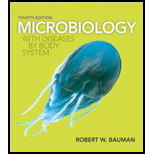
Microbiology with Diseases by Body System (4th Edition)
4th Edition
ISBN: 9780321918550
Author: Robert W. Bauman Ph.D.
Publisher: PEARSON
expand_more
expand_more
format_list_bulleted
Question
Chapter 25, Problem 3MC
Summary Introduction
Introduction:
There are two types of foods depending upon the shelf life of food. They are perishable and nonperishable. The nonperishable food items last for the longer duration of time as compared to perishable food items.
Expert Solution & Answer
Want to see the full answer?
Check out a sample textbook solution
Students have asked these similar questions
Standard Concentration (caffeine) mg/L
Absorbance Reading
10
0.322
20
0.697
40
1.535
60
2.520
80
3.100
Please draw in the missing answer, thank you
Please fill in all blank questions, Thank you
Chapter 25 Solutions
Microbiology with Diseases by Body System (4th Edition)
Ch. 25 - Prob. 1TMWCh. 25 - Prob. 2TMWCh. 25 - Prob. 1MCCh. 25 - Prob. 2MCCh. 25 - Prob. 3MCCh. 25 - Prob. 4MCCh. 25 - Prob. 5MCCh. 25 - Strains of the bacterium Pseudomonas syringae have...Ch. 25 - Prob. 7MCCh. 25 - Prob. 8MC
Ch. 25 - Prob. 9MCCh. 25 - Prob. 19MCCh. 25 - Lyophilization in food preservation is by...Ch. 25 - Prob. 1MTFCh. 25 - Prob. 2MTFCh. 25 - Prob. 3MTFCh. 25 - Prob. 4MTFCh. 25 - Prob. 5MTFCh. 25 - Intrinsic factors affecting food spoilage are...Ch. 25 - Prob. 2FIBCh. 25 - Prob. 3FIBCh. 25 - Potable water is allowed to have ________...Ch. 25 - A ________ is a device composed of microbes and...Ch. 25 - Prob. 10FIBCh. 25 - Prob. 1MCh. 25 - Why does the application or recombinant DNA...Ch. 25 - Given what you know about microbial nutrition and...Ch. 25 - Prob. 3CTCh. 25 - Prob. 4CTCh. 25 - Even though water and wastewater undergo...Ch. 25 - Take a critical look at the garbage in all of your...Ch. 25 - Prob. 7CTCh. 25 - Explain why sakesometimes called rice winewould be...Ch. 25 - Prob. 10CTCh. 25 - Prob. 11CTCh. 25 - Suggest why neither the original food involved nor...Ch. 25 - Prob. 13CTCh. 25 - Prob. 14CTCh. 25 - Prob. 1CMCh. 25 - A blogger stated that germs (microorganisms) are...Ch. 25 - Compare human, animal, and plant pathogens that...Ch. 25 - A microbiome is composed of _____. a. single, pure...Ch. 25 - In the environment, nutrients are generally _____....Ch. 25 - Prob. 12MCCh. 25 - Prob. 13MCCh. 25 - Nitrification converts _____. a. organic nitrogen...Ch. 25 - Prob. 15MCCh. 25 - Which of the following diseases is not caused by...Ch. 25 - Of the following characteristics, which would...Ch. 25 - Anammox reactions are ____. a. anaerobic and pan...Ch. 25 - Prob. 6MTFCh. 25 - Modified True/False 1. _____ Biofilms of...Ch. 25 - Prob. 8MTFCh. 25 - Modified True/False 3. __________ Aquatic...Ch. 25 - Prob. 10MTFCh. 25 - Fill in the Blanks 1. Leaching of compounds from...Ch. 25 - Prob. 6FIBCh. 25 - Prob. 7FIBCh. 25 - Prob. 8FIBCh. 25 - Prob. 1VICh. 25 - Prob. 2VICh. 25 - Prob. 8CTCh. 25 - Microbes are found mostly in topsoil, but some are...
Knowledge Booster
Learn more about
Need a deep-dive on the concept behind this application? Look no further. Learn more about this topic, biology and related others by exploring similar questions and additional content below.Similar questions
- please fill in missing parts , thank youarrow_forwardplease draw in the answers, thank youarrow_forwarda. On this first grid, assume that the DNA and RNA templates are read left to right. DNA DNA mRNA codon tRNA anticodon polypeptide _strand strand C с A T G A U G C A TRP b. Now do this AGAIN assuming that the DNA and RNA templates are read right to left. DNA DNA strand strand C mRNA codon tRNA anticodon polypeptide 0 A T G A U G с A TRParrow_forward
- Please identify the curve shown below. What does this curve represent? Please identify A, B, C, D, and E (the orange oval). What is occurring in these regions?arrow_forwardPlease identify the test shown here. 1) What is the test? 2) What does the test indicate? How is it performed? What is CX? 3) Why might the test be performed in a clinical setting? GEN CZ CX CPZ PTZ CACarrow_forwardDetermine how much ATP would a cell produce when using fermentation of a 50 mM glucose solution?arrow_forward
- Determine how much ATP would a cell produce when using aerobic respiration of a 7 mM glucose solution?arrow_forwardDetermine how much ATP would a cell produce when using aerobic respiration to degrade one small protein molecule into 12 molecules of malic acid, how many ATP would that cell make? Malic acid is an intermediate in the Krebs cycle. Assume there is no other carbon source and no acetyl-CoA.arrow_forwardIdentify each of the major endocrine glandsarrow_forward
arrow_back_ios
SEE MORE QUESTIONS
arrow_forward_ios
Recommended textbooks for you
 Nutrition: Concepts and Controversies - Standalo...Health & NutritionISBN:9781305627994Author:Frances Sizer, Ellie WhitneyPublisher:Brooks ColeEssentials of Pharmacology for Health ProfessionsNursingISBN:9781305441620Author:WOODROWPublisher:Cengage
Nutrition: Concepts and Controversies - Standalo...Health & NutritionISBN:9781305627994Author:Frances Sizer, Ellie WhitneyPublisher:Brooks ColeEssentials of Pharmacology for Health ProfessionsNursingISBN:9781305441620Author:WOODROWPublisher:Cengage


Nutrition: Concepts and Controversies - Standalo...
Health & Nutrition
ISBN:9781305627994
Author:Frances Sizer, Ellie Whitney
Publisher:Brooks Cole

Essentials of Pharmacology for Health Professions
Nursing
ISBN:9781305441620
Author:WOODROW
Publisher:Cengage



What is a Primary and Secondary Metabolite?; Author: Unicity International;https://www.youtube.com/watch?v=TRNUURm0agM;License: Standard Youtube License